
You’re going to love this interview with Toronto-based photographer Holly Sisson, who often incorporates pets into her beautiful family portraits. Holly’s new Siberian kitten, Alice, is also frequently the subject of her amazing work. Holly gives us all sorts of useful technical advice in this interview, so all you budding photographers, enjoy!
How long have you been photographing pets and how did you get started?
I purchased my first Canon DSLR in August 2006, and started shooting professionally in Toronto the next June (2007). I love to incorporate pets into my family sessions, as they are often the first ‘babies’ of the house, and part of the family. In my home we have had a few different pets before our Siberian cat, Alice arrived. I just love animals in general, so have photographed fish, hamsters, horses, dogs and, of course, cats!
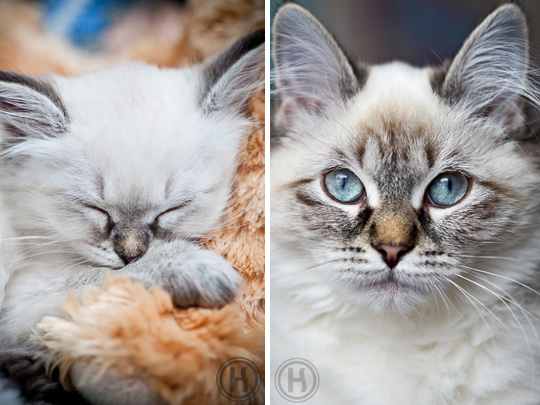
What kind of pet photography do you do? Do you have a specialty?
For the most part, pets are captured as part of my family photography, but I am very interested in pet photography on its own, and always open to a family pet photography session. Since I love all animals, I don’t have a specialty, happy to photograph any and all pets/animals!
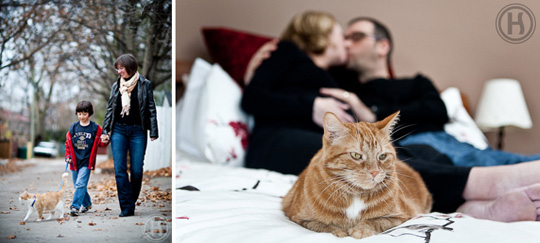
Do you do anything special to prepare for a photo shoot with a cat?
Preparing for a pet photo shoot, in general, would be similar to doing a family shoot. I would discuss with the owner the temperament/personality of their pet (which I do for children as well, very helpful to know prior to the shoot!). Depending on the location (and temperament/personality), I decide which lenses to bring along with my primary Canon body, the 1D MkIV, and my backup Canon, the 5D. It’s very important to have backups, as equipment can fail at any time.
For a pet shoot I would definitely bring my favorite lens, my Canon 85mm f1.2L lens, as it is very bright and excellent for low light conditions. It has wonderful bokeh, which is the background blur you can achieve by shooting with an SLR camera. This is important as it helps to isolate your subject, bringing the focus to them and making the background much less distracting. I would bring my Canon 24-70mm f2.8L lens, which is great for wider angle, and close-up shots. The advantage of a zoom, over a fixed focal length (like the 85mm f1.2L), is that it can make it easier to capture the shot. With a fixed focal lens, you have to move with your feet which is sometimes not possible, and can be distracting to the cat.
I would also bring my Canon 100mm f2.8 macro lens, to capture the amazing eyes of a cat. I could do close ups of cats’ eyes, and never grow tired of it, they really are the windows to the soul.
I would also bring along a specialty lens called a Lensbaby. The Lensbaby has a selective ‘sweet spot’, in which that area is in focus, and everything around it is out-of-focus. I love it for the creative options it gives, it can be great for focusing on select areas, for example the whiskers.
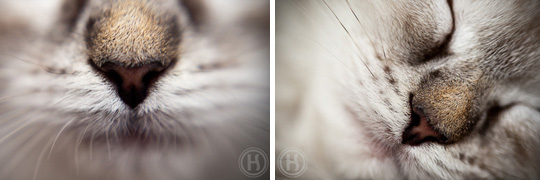
What was the most challenging cat photo shoot you have done? Any funny stories?
Cats, more then almost any other pet, can be extremely challenging just by their very nature. My Siberian, Alice, true to her breed, is very tolerant and good natured. She is not shy, or skittish. Of course the same cannot be said for all cats. I’ve been fortunate that the cats that I have photographed have not been tricky subjects. I have no doubt that there are probably cats out there that couldn’t be photographed professionally, as the whole production of a shoot would scare them to the extreme. A professional camera body and lens are large, and foreign to a cat that is not used to them. I have a Canon 70-200 mm f2.8L IS lens, that I usually use for dog photography. I could see that it could be helpful for a shy cat, assuming there is room to work with that focal length, as it allows me to be much further from the subject then my other lenses.
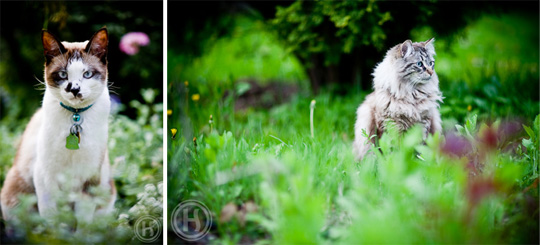
Do you have any tips for readers about how to take great photos of their cats?
Absolutely! The advantage you, as the owner, have over a professional is two fold. One, your cat knows you, trusts you, and is comfortable with you. Two, you know your cat! Typically the images that have the most impact, when you look back at them in years to come, are images that truly capture your cat as they are, their personality, their quirks, etc. Photographs are amazing in that they can transport you back in time, in an instant. Capture your cat in their favorite lounging spot, lying in their funny sleeping position, sitting waiting for dinner (or meowing, as I’m sure Alice isn’t the only one to do so!), etc.
The challenge, if you do not have professional equipment, is working with the limitations of the equipment you do have. If you have a point and shoot, it can be frustrating to capture action, as the camera is slow to shoot compared to an SLR. You could try to pre-focus on a spot where you know the action is going to take place. If you have someone helping you, for example they are playing with your cat while you photograph, you could try to push down halfway on the shutter in the area where the action is taking place. Then have your helper get your cat to that spot. The beauty of digital photography is you can shoot, and shoot, and shoot, and not worry about development costs. Just take an abundance of photos!
Working in the best light possible is extremely important as well. Point and shoot cameras do not perform well in low-light conditions, and you’ll want to avoid the on-camera flash, as it just doesn’t do a good job (shadows, red-eye, not to mention you may frighten your cat).
The other challenge to a P & S camera is depth of field. P & S’s are great at wide angle shots, because they have great depth-of-field, meaning everything is in focus. But you can not capture that beautiful close-up with the background elements out-of-focus (that amazing bokeh), as they are just not capable of doing that. Given that, it is doubly important to photograph your cat in a clean, non-distracting area. Watch out for background clutter. Make sure, when you are reviewing your images, that you check the background for distraction.
I would suggest working to a P & S’s strengths. Do the wide angle ‘environmental’ shots. Make sure to keep composition rules in mind (i.e. it’s generally not a good idea to center your subject, make sure to get down on the same level as your pet, if you shoot from above, shoot from directly above, make it work for the shot).
I believe that some P & S’s are quite good at macro, so focus in tightly on your subject, fill the frame. If your cat likes to sleep by a window, use that to advantage for macro shots, as then you’ll be more likely to capture ‘catch lights’ in the eyes, which bring your subject to life.

For the more technically inclined readers, can you please tell us what equipment you use? (camera, lens, lighting, filters, etc.)
I shoot with Canon equipment, I have the following:
- Primarily camera body is the Canon EOS 1D MkIV. This camera can shoot 10/sec, and has a 1.3 crop factor (focal length x 1.3, e.g. 100mm lens becomes a 130mm lens)
- Backup camera body is the Canon EOS 5D. This is a full frame body, which is great for wide angle shots.
- Canon 85mm f1.2L lens. This is my FAVORITE lens. Amazing in low light, and incredible bokeh.
- Canon 24-70mm f2.8L lens. This is my second most used lens.
- Canon 100mm macro f2.8 lens. Always bring this lens to shoots with pets and children. It is also a great portrait lens.
- Canon 70-200mm f2.8L IS lens. This one is fabulous for certain shoots, i.e. a dog shoot in the park.
- Canon 50mm f1.4. This is my least used lens, it’s only advantage is the shorter focal length for tighter environments, as it is a bright lens, but it just does not compare to the quality of image I can achieve with the 85 f1.2L lens.
- Lensbaby Composer, with telephoto, wide angle, macro and fisheye lens attachments. Fun lens, with the macro kit anything and everything can be fun to photograph.
- Canon 580EX II Speedlite. I prefer to use natural light, as much as possible, but can definitely achieve a better quality image by bouncing this off a wall while shooting.

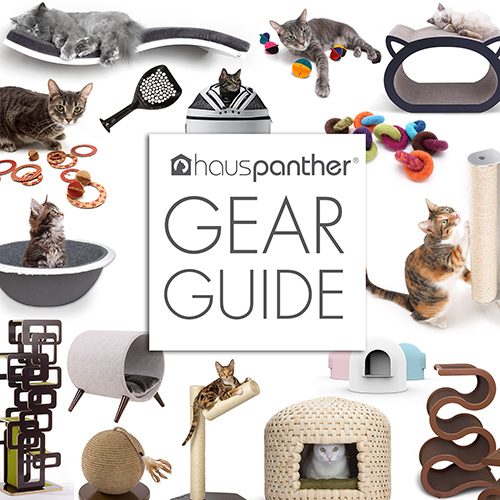
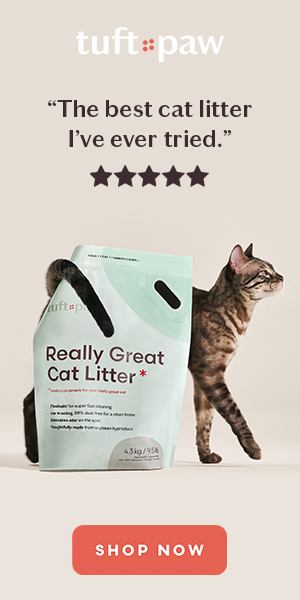
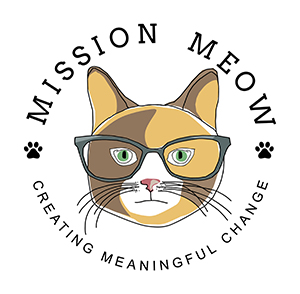


These pictures are fantastic! You capture the cats in great lighting – well done!
i agree!
With the help of my kitty Simba, I picked out 52 simple tips and tricks you can use for photographing your cat or kitten. These are designed to help you make your cat pictures brighter and more attractive.
Check it out: http://simbathebengal.com/cat-photography-tips/